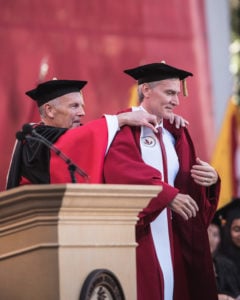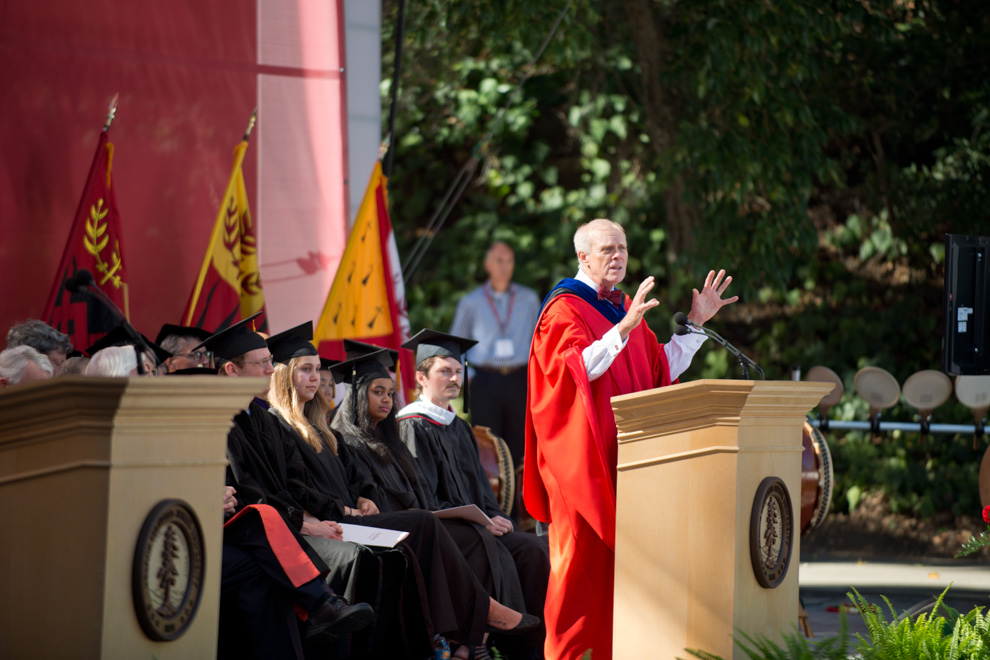
Students, faculty, staff and alumni gathered in Frost Amphitheater on Friday morning to celebrate Marc Tessier-Lavigne’s inauguration as Stanford’s 11th president.
While the ceremony emphasized Stanford’s roots and tradition, Tessier-Lavigne’s speech also addressed future challenges, from maintaining a broad liberal education to upholding the importance of diversity.
The event was grounded in institutional history. Former Stanford presidents Gerhard Casper and John Hennessy gave remarks, and shortly before beginning his address, Tessier-Lavigne donned the traditional President’s Robe with the help of Steve Denning MBA ’78, chair of the Board of Trustees. Additionally, Bella Mabury and Eloise Mabury Knapp Professor in Humanities Eavan Boland read an excerpt from “University Opening Day, 1891,” a passionate speech about investment in young college students that University cofounder Jane Stanford composed but did not deliver at the beginning of Stanford’s first school year.
Tessier-Lavigne’s inaugural address revolved around his view of Stanford as a “purposeful university.” He defined a great research university’s mission as examining and improving humanity in the face of global challenges. The two twin “pillars” of a university’s purpose, he said, are education and “the generation and application of knowledge.”
Regarding the first pillar, education, Tessier-Lavigne lamented the “growing chasm” between the humanities and sciences, and emphasized that “the liberal is vocational.” He argued that society’s problems increasingly demand interdisciplinary thinking, and that students aspiring to enter today’s ever-changing job market will be best served by a breadth-based education.
Tessier-Lavigne himself studied across disciplines: In addition to his acclaimed work in neuroscience, he received a dual degree from Oxford in philosophy and physiology.
Turning to his second pillar, Tessier-Lavigne discussed academic research, noting both its prominence at Stanford given the University’s location in the Silicon Valley and its potential to “stimulate new avenues of fundamental inquiry” in all disciplines. He also defined research as a means to drive positive social impact.
“As a purposeful university, we must not only enable change, but also help understand change and manage change,” he said.
Tessier-Lavigne’s then turned to social issues prevalent on campus, prioritizing the issue of faculty diversity. Even in this forward-looking section of the address, he harkened back to Stanford’s origins as a coeducational, non-denominational university.
“We have made progress in diversifying our faculty, students, and staff, but more needs to be done, especially in representation of women and minorities on our faculty, where we are still far from where we need to be,” he said.
Tessier-Lavigne’s selection as president drew some criticism earlier this year from some students who believed Stanford missed an opportunity to break with its history of white, male leaders. Who’s Teaching Us (WTU), a group of student activists who advocate faculty diversity, originally scheduled a sign-holding demonstration during the inauguration to press for greater diversity at Stanford, but decided on Thursday evening to cancel the activities.
Colin Kimzey ’17, a WTU member, told The Daily that WTU ultimately decided plans were “not necessary,” particularly because Tessier-Lavigne met with representatives from the group last Tuesday to hear its agenda. Kimzey noted that Hennessy did not meet with the group during his term as president.
“To be honest, we got some pushback from within our community and the community kind of encompassed by the coalition,” Kimzey said. “The worry was that this would be perceived as a protest and too early, when this president hasn’t had a chance to show his commitment to diversity.”
In his speech, Tessier-Lavigne stressed the University’s dedication to diversity, citing his own experience as the first in his family to attend college. He also affirmed his commitment to freedom of expression and eradication of campus sexual assault.
“Inclusion must be central to our efforts in the coming decade,” Tessier-Lavigne said. “This starts with reaffirming our culture of civility, and our culture of respect for the dignity of every member of our community, and includes a rejection of all forms of violence, including the sexual violence that has roiled our campus, for which we have zero tolerance.”
Tessier-Lavigne’s remarks on Stanford’s campus climate drew applause from the audience.
The ceremony was interspersed with student performances, framing scholarly remarks with arts performances by undergraduate groups. Stanford Taiko performed the inauguration’s opening number, while a capella group Talisman sang “Amazing Grace” before President Gerhard Casper’s remarks. A number of other student groups performed, from choral groups to instrumental ensembles.
Additionally, Tessier-Lavigne’s son Kyle Tessier-Lavigne performed John Butler’s “Ocean” on acoustic guitar. While his son played, Marc Tessier-Lavigne broke his more measured posture to lean forward, smiling toward Kyle’s seat on stage right.
As Thursday marked the beginning of Stanford’s Reunion Homecoming weekend, many alumni attended Tessier-Lavigne’s inauguration.
“I was very impressed with the new president, and it seems like the University will be in good hands,” said Timothy Sullivan ’85 M.S. ’88.
Former President John Hennessy echoed Sullivan’s sentiments in his speech.
“I share [Tessier-Lavigne’s] optimism about the future of our university and its ability to be of even greater service to the world,” Hennessy said. “From my perspective, he is eminently qualified to be Stanford’s 11th president… I have great confidence that with our enthusiastic support, Marc will lead Stanford to new heights.”
Contact Courtney Douglas at ccd4 ‘at’ stanford.edu.
